
According to the National Library of Medicine, In India, around 6% of the adult population is affected by sexually transmitted infections (STIs) or reproductive tract infections (RTIs), leading to an estimated 30–35 million new cases annually. Despite this high prevalence, there are several misconceptions that contribute to the spread of STIs.
We reached out to our expert Dr Umesh N Jindal-Obstetrician and Gynecologist, Director of Jindal IVF Chandigarh to understand these myths and debunk them.
Below are the common myths and facts related to STI:

Fact: “One common notion is that if there are no symptoms, there’s no infection. Many people assume that feeling healthy means they are STI-free, but many infections, such as chlamydia and HPV, can remain asymptomatic for long periods. This false belief leads to a lack of testing and early detection, increasing the risk of unknowingly spreading infections,” said Dr Umesh.
Fact: Another prevalent belief is that STIs only affect individuals with multiple sexual partners or those engaged in high-risk behaviors. However, anyone who is sexually active can contract an STI, regardless of their partner count or sexual history. Similarly, there's a misconception that STIs always come with visible signs, like sores or pain, which leads people to overlook the risk when no symptoms appear. This is particularly dangerous with infections like herpes or HPV, which can be dormant or show no obvious symptoms.
Don't Miss: Here's How Poor Menstrual Hygiene Can Lead To STIs/STDs And Affect Your Love Life

Fact: “While condoms and dental dams reduce the risk, they don’t offer 100% protection against all types of infections, such as herpes, syphilis, or HPV, which can still be transmitted through skin-to-skin contact. Many also think that being in a monogamous relationship or having occasional sexual encounters eliminates the risk of STIs. In reality, even a single sexual encounter with an infected partner can lead to transmission, as many STIs are asymptomatic,” said Dr Umesh.
Don't Miss: STIs And Vaginal Itching: Possible Link, Prevention, What To Do, According to Expert
To effectively combat the spread of STIs, regular medical testing is crucial. Testing is the only reliable method to detect infections, especially when symptoms are absent. It allows for early treatment, preventing severe health consequences and limiting the transmission to others.
If you liked this story, then please share it. To read more such stories, stay connected to HerZindagi.
Credits: Freepik
Also watch this video
Herzindagi video
Our aim is to provide accurate, safe and expert verified information through our articles and social media handles. The remedies, advice and tips mentioned here are for general information only. Please consult your expert before trying any kind of health, beauty, life hacks or astrology related tips. For any feedback or complaint, contact us at compliant_gro@jagrannewmedia.com.